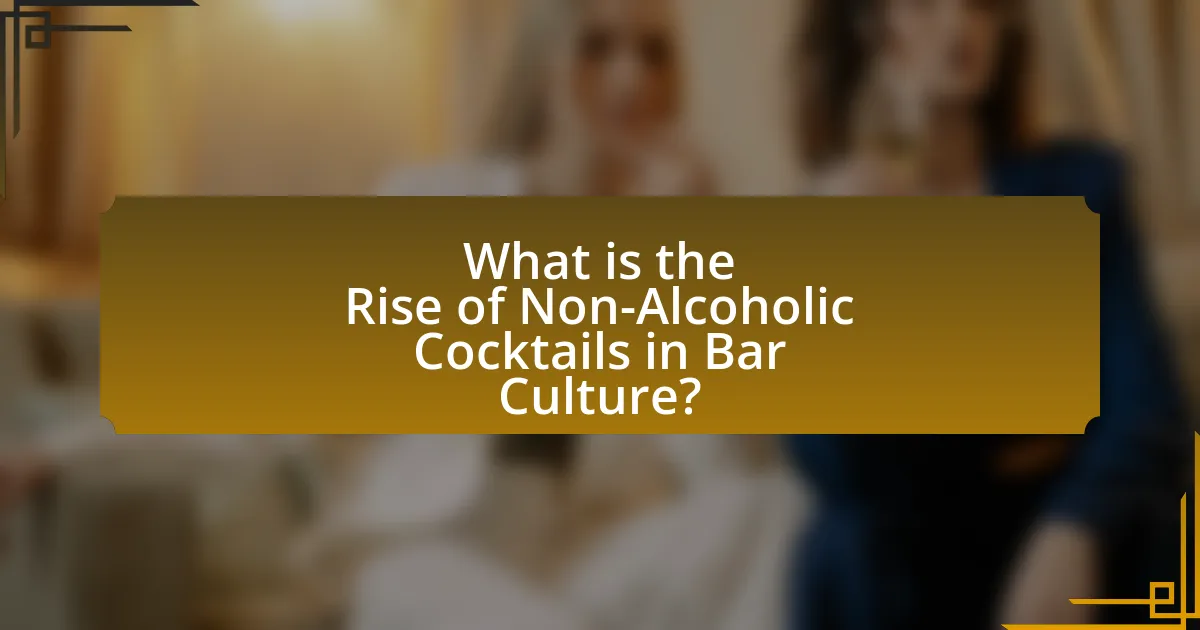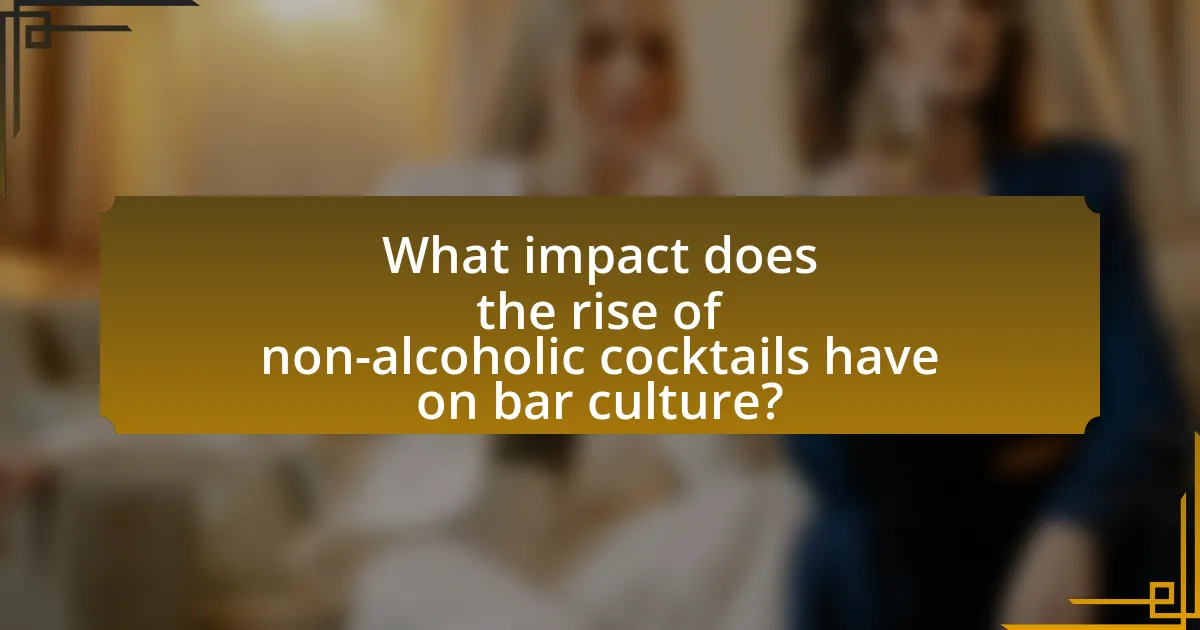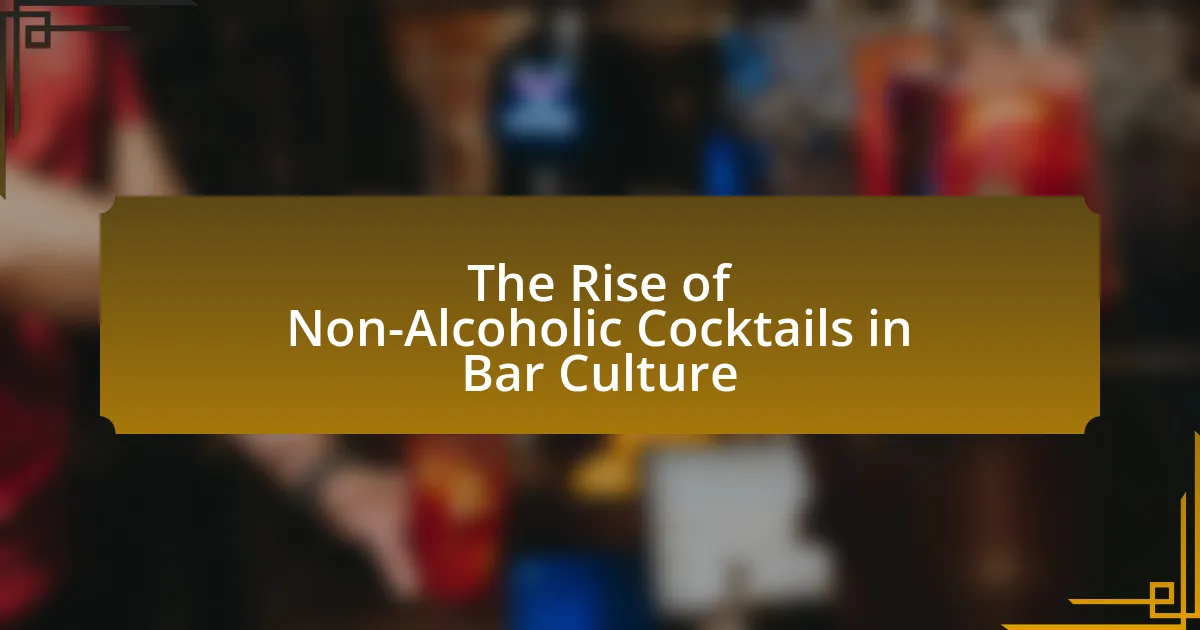The article examines the rise of non-alcoholic cocktails in bar culture, highlighting a significant trend towards inclusivity and health-conscious choices among consumers. It discusses the evolution of non-alcoholic cocktails from simple mocktails to complex beverages, driven by increased health awareness and changing social norms. Key factors influencing this trend include a growing demand for healthier options, the popularity of mindful drinking movements, and the impact of social dynamics on acceptance. The article also outlines the characteristics of non-alcoholic cocktails, popular recipes, and the innovative approaches taken by modern mixologists to enhance flavor and presentation, ultimately transforming the bar experience for a diverse clientele.

What is the Rise of Non-Alcoholic Cocktails in Bar Culture?
The rise of non-alcoholic cocktails in bar culture signifies a growing trend towards inclusivity and health-conscious choices among consumers. This shift is evidenced by a 2021 report from the IWSR, which indicated that the global non-alcoholic beverage market is projected to grow by 31% by 2024. Bars are increasingly offering sophisticated non-alcoholic options, catering to a diverse clientele that includes those who abstain from alcohol for health, personal, or lifestyle reasons. This trend reflects a broader cultural movement towards mindful drinking, where consumers seek flavorful, complex beverages without the effects of alcohol.
How have non-alcoholic cocktails evolved in recent years?
Non-alcoholic cocktails have evolved significantly in recent years, transitioning from simple mocktails to complex, flavorful beverages that mimic traditional cocktails. This evolution is driven by a growing consumer demand for healthier options and inclusivity in social settings, with a 2021 report from IWSR indicating a 31% increase in non-alcoholic beverage sales globally. Bartenders now utilize innovative ingredients such as non-alcoholic spirits, fresh herbs, and artisanal mixers to create sophisticated flavor profiles, reflecting a shift in bar culture that embraces creativity and craftsmanship in non-alcoholic offerings.
What cultural shifts have contributed to this evolution?
The cultural shifts contributing to the rise of non-alcoholic cocktails in bar culture include increased health consciousness, changing social norms regarding alcohol consumption, and the growing demand for inclusivity in social settings. Health consciousness has surged as individuals prioritize wellness, leading to a decline in alcohol consumption; for instance, a 2021 survey by the International Wine and Spirits Record indicated that 27% of consumers are reducing their alcohol intake. Additionally, social norms have evolved, with younger generations, particularly Millennials and Gen Z, favoring moderation and mindful drinking, as evidenced by the rise of sober-curious movements. Lastly, the demand for inclusivity has prompted bars to create non-alcoholic options, catering to diverse preferences and lifestyles, which has been supported by industry reports showing a 500% increase in non-alcoholic spirit sales from 2019 to 2021.
How do consumer preferences influence the rise of non-alcoholic cocktails?
Consumer preferences significantly influence the rise of non-alcoholic cocktails by driving demand for healthier and more inclusive drinking options. As awareness of health and wellness increases, many consumers are opting for beverages that offer the social experience of cocktails without the effects of alcohol. A survey by the International Wine and Spirits Record found that 27% of consumers are actively seeking non-alcoholic alternatives, indicating a substantial shift in drinking habits. This trend is further supported by the growing popularity of mindful drinking movements, which encourage moderation and promote non-alcoholic options in social settings. Consequently, bars and restaurants are expanding their menus to include a variety of creative non-alcoholic cocktails, catering to this evolving consumer preference.
Why are non-alcoholic cocktails gaining popularity?
Non-alcoholic cocktails are gaining popularity due to a growing consumer demand for healthier lifestyle choices and inclusivity in social settings. Research indicates that 27% of adults in the U.S. are reducing their alcohol consumption, driven by health concerns and a desire for mindful drinking. This trend is reflected in the beverage industry, where sales of non-alcoholic spirits and mixers have surged, with a reported growth of 31% in the non-alcoholic beverage market from 2020 to 2021. Additionally, bars and restaurants are increasingly offering creative non-alcoholic options to cater to diverse customer preferences, enhancing the social experience without the effects of alcohol.
What health trends are driving the demand for non-alcoholic options?
Health trends driving the demand for non-alcoholic options include increased awareness of the negative effects of alcohol on health, a growing focus on wellness and mindfulness, and the rise of sober-curious lifestyles. Research indicates that 30% of millennials are choosing to drink less alcohol, reflecting a shift towards healthier living. Additionally, studies show that 66% of consumers are interested in non-alcoholic beverages as part of their health-conscious choices, highlighting a significant market trend.
How do social dynamics affect the acceptance of non-alcoholic cocktails?
Social dynamics significantly influence the acceptance of non-alcoholic cocktails by shaping perceptions and behaviors around drinking culture. As social gatherings increasingly prioritize inclusivity and health consciousness, the demand for non-alcoholic options rises. Research indicates that 66% of consumers are more likely to choose non-alcoholic beverages when they are socially accepted within their peer groups (IWSR, 2021). Additionally, social media trends and influencer endorsements further normalize non-alcoholic cocktails, making them more appealing in social settings. This shift reflects a broader cultural movement towards wellness and moderation, which enhances the visibility and acceptance of non-alcoholic cocktails in bars and restaurants.

What are the key characteristics of non-alcoholic cocktails?
Non-alcoholic cocktails, also known as mocktails, are characterized by their ability to provide complex flavors and appealing presentations without the inclusion of alcohol. These beverages often utilize a variety of fresh fruits, herbs, spices, and mixers to create a balanced taste profile that mimics traditional cocktails. Additionally, non-alcoholic cocktails frequently feature creative garnishes and vibrant colors, enhancing their visual appeal and making them suitable for social occasions. The growing trend towards health-conscious drinking has further popularized these drinks, as they offer a flavorful alternative for individuals seeking to reduce alcohol consumption while still enjoying a festive beverage experience.
How do non-alcoholic cocktails differ from traditional cocktails?
Non-alcoholic cocktails differ from traditional cocktails primarily in their lack of alcohol content. Traditional cocktails typically contain spirits, which contribute to their flavor profile and intoxicating effects, while non-alcoholic cocktails, also known as mocktails, use a combination of juices, sodas, herbs, and other flavorings to create complex tastes without the alcohol. This distinction allows non-alcoholic cocktails to cater to individuals seeking social experiences without the effects of alcohol, reflecting a growing trend in bar culture that emphasizes inclusivity and health-conscious choices.
What ingredients are commonly used in non-alcoholic cocktails?
Common ingredients used in non-alcoholic cocktails include fresh fruits, herbs, juices, syrups, and soda water. Fresh fruits like citrus (lemons, limes, oranges) provide acidity and flavor, while herbs such as mint and basil add aromatic qualities. Juices, particularly from fruits like pineapple and cranberry, serve as the base for many drinks. Simple syrups, made from sugar and water, enhance sweetness, and soda water adds effervescence, creating a refreshing texture. These ingredients are widely recognized in the mixology community for their ability to create flavorful and appealing beverages without alcohol.
How do flavor profiles compare between alcoholic and non-alcoholic cocktails?
Flavor profiles in alcoholic cocktails typically feature a broader range of complex flavors due to the presence of alcohol, which can enhance the perception of taste and aroma. In contrast, non-alcoholic cocktails often rely on a combination of fresh ingredients, syrups, and mixers to create flavor, resulting in lighter and sometimes less intense profiles. Alcohol acts as a solvent that extracts and amplifies flavors, while non-alcoholic options may focus more on balancing sweetness, acidity, and herbal notes without the depth that alcohol provides. This distinction is evident in the growing trend of non-alcoholic spirits designed to mimic the complexity of their alcoholic counterparts, indicating a shift in bar culture towards inclusivity and diverse flavor experiences.
What types of non-alcoholic cocktails are popular today?
Popular types of non-alcoholic cocktails today include mocktails such as Virgin Mojitos, Nojito, and Seedlip-based drinks. These beverages have gained popularity due to the increasing demand for alcohol-free options, with the global non-alcoholic beverage market projected to reach $1.6 trillion by 2025. Additionally, creative combinations of fresh juices, herbs, and flavored syrups are frequently used to craft sophisticated non-alcoholic drinks, appealing to consumers seeking flavorful alternatives without alcohol.
What are some classic non-alcoholic cocktail recipes?
Classic non-alcoholic cocktail recipes include the Virgin Mojito, Shirley Temple, and Virgin Pina Colada. The Virgin Mojito combines fresh mint, lime juice, sugar, and soda water, offering a refreshing taste without alcohol. The Shirley Temple features ginger ale, grenadine, and a splash of orange juice, garnished with a cherry, making it a popular choice for all ages. The Virgin Pina Colada blends pineapple juice and coconut cream, creating a tropical flavor reminiscent of the original cocktail. These recipes exemplify the creativity and appeal of non-alcoholic options in modern bar culture, catering to those seeking flavorful beverages without alcohol.
How are modern mixologists innovating with non-alcoholic cocktails?
Modern mixologists are innovating with non-alcoholic cocktails by incorporating unique ingredients, advanced techniques, and creative presentations. They utilize fresh herbs, exotic fruits, and artisanal syrups to enhance flavor profiles, while also employing methods such as sous-vide infusion and carbonation to elevate the drinking experience. For example, the use of non-alcoholic spirits, like Seedlip, has gained popularity, allowing mixologists to craft complex, layered drinks that mimic traditional cocktails without alcohol. This innovation reflects a growing trend in the bar culture, where 30% of consumers are seeking non-alcoholic options, as reported by the IWSR Drinks Market Analysis.

What impact does the rise of non-alcoholic cocktails have on bar culture?
The rise of non-alcoholic cocktails significantly transforms bar culture by promoting inclusivity and expanding consumer choices. As more individuals seek healthier lifestyles or choose to abstain from alcohol, bars are adapting their menus to include sophisticated non-alcoholic options, which enhances the overall experience for patrons. According to a report by IWSR Drinks Market Analysis, the non-alcoholic beverage market is projected to grow by 31% globally by 2024, indicating a substantial shift in consumer preferences. This trend encourages bars to innovate and create unique, flavorful drinks that appeal to a broader audience, thereby fostering a more diverse social environment.
How are bars adapting their menus to include non-alcoholic options?
Bars are adapting their menus to include non-alcoholic options by introducing a variety of creative mocktails, alcohol-free spirits, and enhanced soft drinks. This shift is driven by the increasing demand for inclusive drinking experiences, as evidenced by a 2021 report from the International Wine and Spirit Research, which noted a 31% growth in the non-alcoholic beverage market. Many establishments are now employing mixologists to craft sophisticated non-alcoholic cocktails that mimic the complexity of traditional drinks, thereby appealing to a broader audience. Additionally, bars are often highlighting these options on their menus to ensure visibility and encourage patrons to explore alternatives to alcohol.
What challenges do bars face when incorporating non-alcoholic cocktails?
Bars face several challenges when incorporating non-alcoholic cocktails, primarily related to customer perception, ingredient sourcing, and staff training. Customer perception often presents a hurdle, as many patrons may associate cocktails exclusively with alcohol, leading to a lack of interest in non-alcoholic options. Additionally, sourcing high-quality ingredients for non-alcoholic cocktails can be difficult, as bars may struggle to find unique and flavorful alternatives that meet the expectations of discerning customers. Staff training is also a significant challenge; bartenders need to be knowledgeable about non-alcoholic options and skilled in crafting these drinks to ensure they are appealing and well-executed. These challenges can hinder the successful integration of non-alcoholic cocktails into a bar’s menu.
How does the inclusion of non-alcoholic cocktails affect customer experience?
The inclusion of non-alcoholic cocktails positively affects customer experience by providing inclusive options that cater to diverse preferences and lifestyles. This inclusivity enhances social interactions, allowing individuals who may not consume alcohol to participate fully in social settings. Research indicates that 66% of consumers are interested in non-alcoholic beverages, reflecting a growing demand for such options in bars and restaurants. By offering non-alcoholic cocktails, establishments can attract a broader customer base, improve customer satisfaction, and foster a more welcoming environment.
What role do non-alcoholic cocktails play in social settings?
Non-alcoholic cocktails serve as inclusive beverage options in social settings, allowing individuals who choose not to consume alcohol to participate fully in social interactions. These drinks enhance the social experience by providing flavorful alternatives that mimic traditional cocktails, thus fostering a sense of belonging among all attendees. The increasing popularity of non-alcoholic cocktails is evidenced by a 2021 report from the International Bartenders Association, which noted a 30% rise in demand for non-alcoholic options in bars, reflecting a shift towards more inclusive drinking cultures.
How do non-alcoholic cocktails facilitate inclusivity in social gatherings?
Non-alcoholic cocktails facilitate inclusivity in social gatherings by providing enjoyable beverage options for individuals who choose not to consume alcohol. These cocktails allow non-drinkers to participate fully in social experiences without feeling excluded or pressured to drink alcohol. Research indicates that 29% of adults in the U.S. are choosing to drink less alcohol or abstain altogether, highlighting a growing demand for non-alcoholic options that cater to diverse preferences and lifestyles. By offering a variety of flavorful and visually appealing non-alcoholic cocktails, hosts can create an environment where everyone feels welcome and included, regardless of their drinking choices.
What are the perceptions of non-drinkers regarding non-alcoholic cocktails?
Non-drinkers generally perceive non-alcoholic cocktails as a positive and inclusive option within bar culture. Many non-drinkers appreciate the creativity and variety offered by these beverages, viewing them as a way to enjoy social settings without alcohol. Research indicates that 66% of non-drinkers feel that non-alcoholic cocktails allow them to participate in social experiences without compromising their lifestyle choices. Additionally, non-drinkers often express that these drinks provide a sophisticated alternative to traditional soft drinks, enhancing their overall dining and social experience.
What are some best practices for creating non-alcoholic cocktails?
Best practices for creating non-alcoholic cocktails include using fresh ingredients, balancing flavors, and incorporating unique textures. Fresh fruits, herbs, and spices enhance the taste and visual appeal, while balancing sweet, sour, and bitter elements ensures a well-rounded flavor profile. Additionally, using ingredients like tonic water, soda, or flavored syrups can add complexity and texture, making the drink more enjoyable. These practices align with trends in the bar culture that emphasize creativity and inclusivity, catering to a growing audience seeking flavorful alternatives to alcoholic beverages.
How can home bartenders craft delicious non-alcoholic cocktails?
Home bartenders can craft delicious non-alcoholic cocktails by using fresh ingredients, creative flavor combinations, and proper techniques. Utilizing fruits, herbs, and spices allows for vibrant flavors; for example, muddling mint with lime creates a refreshing base. Additionally, incorporating mixers like tonic water, soda, or flavored syrups enhances complexity. Techniques such as shaking, stirring, and garnishing with visually appealing elements like citrus slices or herbs elevate the presentation. The growing trend of non-alcoholic cocktails is supported by a 2021 report from IWSR, which indicates a 31% increase in non-alcoholic beverage consumption, highlighting the demand for flavorful alternatives.
What tips can enhance the presentation of non-alcoholic cocktails?
To enhance the presentation of non-alcoholic cocktails, utilize vibrant garnishes, elegant glassware, and creative layering techniques. Vibrant garnishes such as fresh herbs, edible flowers, or colorful fruits can add visual appeal and freshness, while elegant glassware elevates the overall aesthetic, making the drink feel special. Creative layering techniques, where different ingredients are poured carefully to create distinct layers, can also enhance visual interest. Research indicates that visually appealing drinks can increase customer satisfaction and engagement, making presentation a key factor in the enjoyment of non-alcoholic cocktails.
